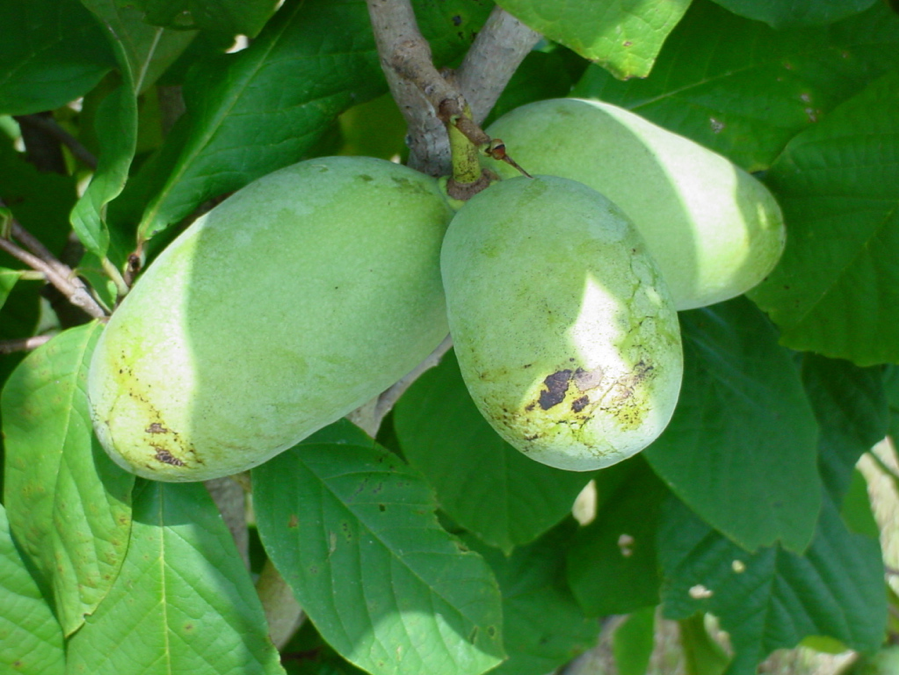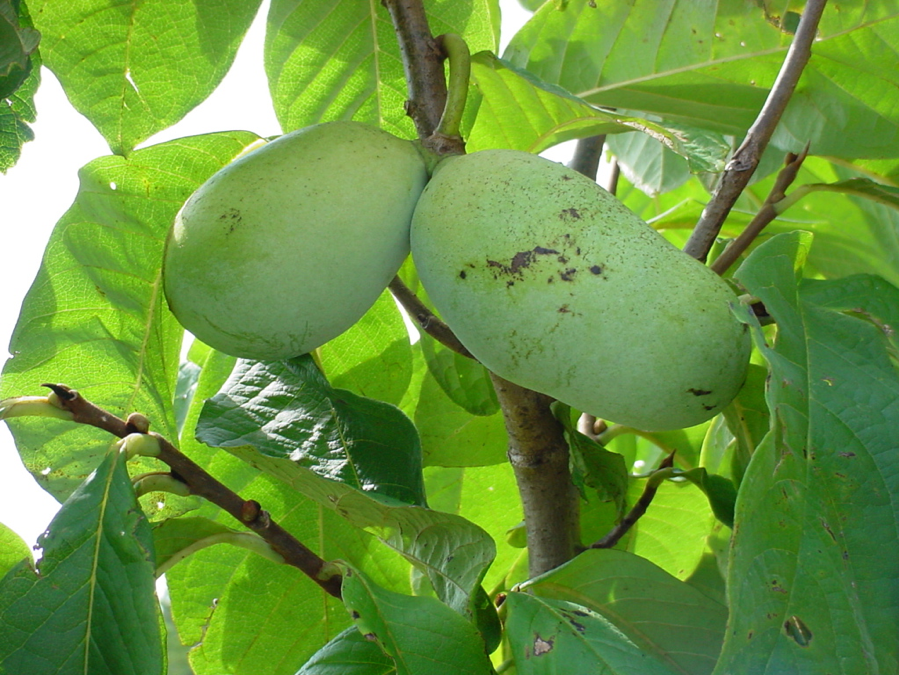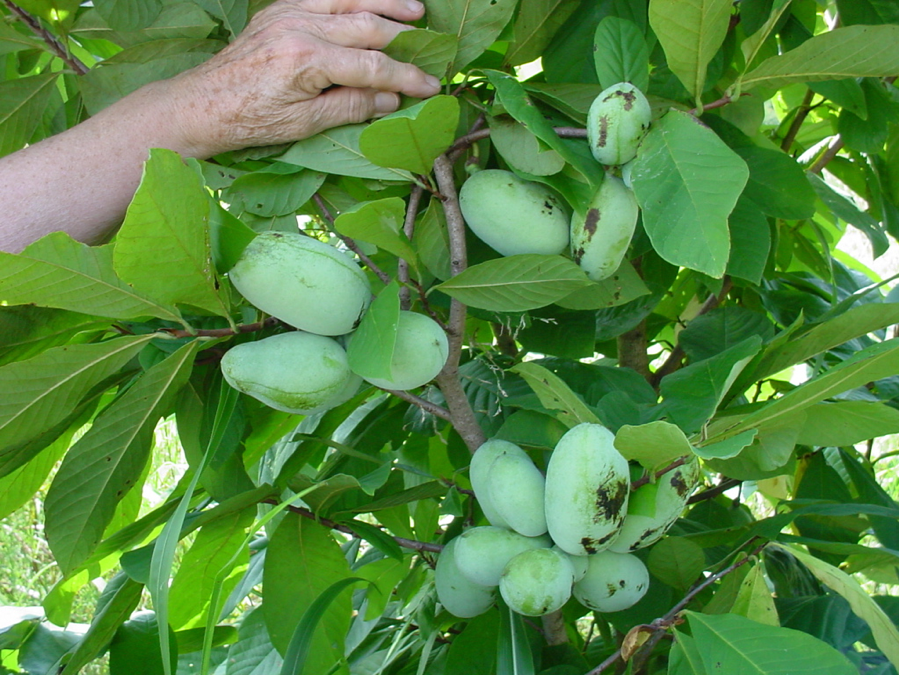Journal of the NACAA
ISSN 2158-9429
Volume 13, Issue 1 - June, 2020
Pawpaw Cultivar Evaluation: 2007-2019
- Cantaluppi, C.J. , Retired Area Horticulture Agent , North Carolina Cooperative Extension Service
Coley, J.W., Area Horticulture Agent, North Carolina Cooperative Extension Service
ABSTRACT
In an effort to evaluate specialty crops to provide a higher income per acre to growers, the Pawpaw provides an opportunity to bring a “lost” fruit into the public eye. Efforts by plant breeders have “re-discovered” this delicious fruit with a flavor that has been described as a cross between a pineapple, mango, and banana. Pawpaw genotypes have been selected for superior flavor, lesser seed content, and large fruit size, making it a very desirable, high-value horticultural crop that is attractive to consumers. A replicated cultivar trial of Pawpaw (Asimina triloba) was conducted to compare the yield and quality of the four cultivars and to ultimately make recommendations to growers. Pounds of fruit per tree and pounds of fruit per acre were higher for the Shenandoah cultivar in 2013. Susquehanna cultivar had the largest fruit weight from 2013-2019. Susquehanna cultivar had the greatest yield in pounds of fruit per acre for 2013, 2015, 2017, and 2019. The Allegheny cultivar had the highest number of fruits per tree as compared to other cultivars from 2013-2019.
INTRODUCTION
Pawpaw (Asimina triloba) belongs to the Annonaceae, or the Custard Apple family, which consists of a large family of trees, shrubs, and lianas that are widespread throughout the Old and New World tropics. Some of the finest fruits in the world belong to the tropical Annonaceae: namely cherimoya, guanabana (also called soursop), sweetsop, and custard apple. The genus Asimina is endemic to the temperate deciduous forests of eastern North America, and contains eight other species besides A. triloba. A. triloba is a wholly temperate climate species, the northernmost ranging and hardiest of the Asimina, which makes it unique among the Annonaceae. It is endemic to most of the northeastern states, excluding all of New York and New England.
Its range extends from the Great Lakes south to the Florida panhandle, west to eastern Texas and north, including eastern Oklahoma, Kansas, and southeast Nebraska. However, its range does not extend north of Missouri into Iowa except for the southeastern part, which borders along the Mississippi River and does not include the state of Wisconsin or north of the southern third of Michigan. A. triloba is the largest edible native fruit of North America. Other Asimina do not have fruit as large or as delicious. A. triloba is (almost) among the last trees to leaf out in the spring, concurring with black walnut, a trait reflecting its tropical origins. Although the young leaves often appear chlorotic, it is only temporary (Peterson, 2013).
In 1916, The American Genetics Association held a contest to exhibit the best pawpaws. The purpose of that contest was to promote commercial cultivars by "intelligent breeding" but it did not come to pass (Popenoe, (ed.) 1916; Popenoe, (ed.) 1917). Between 1900 to 1950, pawpaw variety development included widespread selection from the wild and resulted in numerous cultivars. However, few breeders were active, and no commercialized cultivars were developed through breeding efforts. Between 1950 and 1985, many cultivars were selected from both wild and cultivated sources. Increased breeding efforts produced several cultivars from open-pollinated crosses. The preservation of germplasm from this period was not an issue, since cultivars were widely disseminated (Peterson, 2003).
During the last decades of the 20th century, an increase occurred in activity in pawpaw domestication. In 1981, Neal Peterson began a large-scale breeding program to develop improved pawpaw cultivars (Peterson,1982; Peterson,1986). With the cooperation of the University of Maryland, he established evaluation orchards at their agricultural experiment stations: the Wye at Queenstown, MD, and at Keedysville, MD. All 1,483 accessions were open-pollinated seedlings, with most from plant material that survived in the collections of four pawpaw breeders between 1985-2000. Secondary germplasm came from other minor collections of the period, certain wild stands, and seven named cultivars (Peterson, 2003).
By 1994, Peterson had selected 18 advanced numbered selections and these were included with 10 named cultivars in an array of regional genotype trials conducted at 12 universities (Pomper et al., 1999). He identified three of his selections as superior: 'Shenandoah', 'Rappahannock', and 'Susquehanna' as of 2003 and as of 2015, he has named three others; 'Allegheny', 'Potomac', and 'Wabash' (Peterson, 2003).
In addition to the work of Peterson, a contest was conducted by Brett Callaway, Horticulturist at Kentucky State University (KSU), who patterned his contest on that of 1916 and meant to gather a wide geographic breadth of germplasm with which to initiate a breeding program. His contest generated more than 400 entries from 14 states in 1990 (Peterson, 2003).
The Callaway contest marked the beginning of a committed pawpaw research program at KSU, first headed by Callaway (1991-1993), then Desmond Layne (1993-1997), and currently Kirk Pomper (1998-Present). A germplasm collection was started in 1991 with the seed collected through the contest. In 1994, KSU was designated the official Asimina satellite repository of the USDA National Clonal Germplasm Repository, Corvallis, OR. Peterson, R.N. 2003. As of 2003, this contains over 1700 accessions, including 40 cultivars, from 16 states (Layne, 1996; Pomper et al., 2007).
Peterson's breeding project was the first pawpaw breeding and evaluation project involving thousands of seedlings, statistical measurements, and the use of selection indices. His project demonstrates the results of one person working for 20 years with limited resources. His design emphasized both fruit quantity and quality, consisting of more than 1000 accessions using seedlings from the best germplasm available (Peterson, 2003).
The task of pawpaw breeding is now in the hands of amateur scientists with minimal institutional backing; KSU is an exception. The present pawpaw industry is too small for university breeding programs. Therefore, breeding is likely to occur with amateurs, who should join groups like the Northern Nut Growers Association, and familiarize themselves with pawpaw history, biology, genetic resources, and pollination techniques (Peterson, 2003).
Pawpaw breeding is a long-term research program, requiring over 10 years per generation and 6 years for evaluation. However, neither extravagant budgets nor extensive acreage are required. Two or three acres will suffice. Persistence, a love of pawpaws, a logical mind, attention to detail, habits of close observation, and familiarity with the scientific method are required (Peterson, 2003).
MATERIALS AND METHODS
One-year-old trees that were budded in the fall of 2006 at Peterson Pawpaws in Winchester, VA were manually dug at the nursery on April 23, 2007 and were planted on the farm of Doreathy Booth, 12 miles north of Oxford, NC on April 24, 2007 in a Cecil clay loam soil.
The trial consists of four different cultivars; Allegheny, Potomac, Shenandoah, and Susquehanna, that were bred and released by Mr. R. Neal Peterson, horticultural scientist and geneticist. The characteristics of the cultivars as noted by Peterson (2013) are as follows:

Figure 1. Shenandoah Pawpaw
The tree originated as a seedling of 'Overleese' and is superior to its parent. It has large fruit size with few seeds (6% by weight). Flesh texture is firmer than wild pawpaws, and has a sweet mild flavor. Fruit is often borne in single-fruited clusters. Good yields. Responds well to pruning (Peterson, 2013).

Figure 2. Susquehanna Pawpaw
This variety is outstanding for combining very large size with rich pawpaw flavor, great sweetness, exceptional fleshiness, and firm buttery texture, similar to avocado and a thickish skin; it is less fragile than other cultivars. It also can be utilized as a beautiful ornamental tree in the home landscape. Susquehanna originated as a seedling from the collection of the University of Virginia Blandy Experimental Farm in Boyce, VA. Fruits can weigh over one pound. It has the fewest seeds of any cultivar (3% by weight). It has moderate to good yields and responds well to pruning (Peterson, 2013).

Figure 3. Potomac Pawpaw
It is extremely fleshy. The percent seed is about 4% by weight. It has a sweet and rich flavor and a firm, melting, and smooth texture. Flesh color is medium yellow. The tree is medium in productivity with a strong apical dominance, and is very upright and less spreading than other cultivars. Fruit size is typically 12 ounces or more, and quality is impressive (Peterson, 2013).

Figure 4. Allegheny Pawpaw
Flavor is sweet and rich, with a hint of citrus. Texture is medium firm and smooth with a yellow flesh color. Fruit size is typically less than 8 ounces. It is very productive to the point that fruit size suffers. Trees will require fruit thinning to keep fruit size over 8 ounces. Fruit size is smaller and seedier than other cultivars, with a percent seed of 8% by weight (Peterson, 2013).
Each of the four cultivars is replicated six times. One tree equals one replication. The trial held 24 trees in total. The trees were spaced 10 feet between trees in the row and 15 feet between rows. The orchard was maintained in permanent sod culture, which was mowed throughout the season. Trees were irrigated with drip irrigation during the planting year, and only by natural rainfall in subsequent years. Trees were limed and fertilized based on soil test results each year. Cantaluppi maintained the trial, harvested fruit, recorded, and analyzed the data in 2013 and 2015, before retiring in 2016. Coley maintained the trial, harvested fruit, and recorded the data from 2017 to 2019. Cantaluppi then analyzed Coley’s data from the 2017-2019 seasons.
RESULTS AND DISCUSSION
Table 1. Number of Fruit Per Tree1
|
Cultivar |
2013 |
2015 |
2017 |
2018 |
2019 |
|
Allegheny |
13a |
18a |
11a |
98a |
43a |
|
Shenandoah |
8ab |
8a |
9a |
45b |
21ab |
|
Susquehanna |
6ab |
14a |
7a |
30b |
17ab |
|
Potomac |
5b |
14a |
5a |
30b |
5b |
1Cultivars with the same letter within column are not statistically significant, Duncan’s Multiple Range Test, 5% level.
Table 2. Average Weight of Fruit in Lbs.1
|
Cultivar |
2013 |
2015 |
2017 |
2018 |
2019 |
|
Susquehanna |
0.58a |
0.76a |
0.55a |
0.61a |
0.43a |
|
Shenandoah |
0.51a |
0.47b |
0.50a |
0.33b |
0.30ab |
|
Potomac |
0.41ab |
0.64a |
0.43a |
0.61a |
0.17bc |
|
Allegheny |
0.30b |
0.34b |
0.38a |
0.23b |
0.12c |
1Cultivars with the same letter within column are not statistically significant, Duncan’s Multiple Range Test 5% level.
Table 3. Yield in Pounds of Fruit Per Tree1
|
Cultivar |
2013 |
2015 |
2017 |
2018 |
2019 |
|
Susquehanna |
3.9a |
5.9a |
4.9a |
19.7a |
7.87a |
|
Allegheny |
3.9a |
5.7a |
4.0a |
22.0a |
6.95ab |
|
Shenandoah |
4.1a |
5.7a |
4.1a |
17.4a |
6.87ab |
|
Potomac |
2.2a |
8.9a |
2.2a |
18.6a |
1.57 b |
1Cultivars with the same letter within column are not statistically significant, Duncan’s Multiple Range Test, .05 level.
Table 4. Yield in Pounds of Fruit Per Acre1
|
Cultivar |
2013 |
2015 |
2017 |
2018 |
2019 |
|
Susquehanna |
1,139a |
1,737a |
1,431a |
5,723a |
2,281a |
|
Allegheny |
1,124a |
1,660a |
1,166a |
6,386a |
2,018ab |
|
Shenandoah |
1,184a |
1,651a |
1,092a |
5,051a |
1,987ab |
|
Potomac |
639a |
2,590a |
635a |
5,384a |
445b |
1Cultivars with the same letter within column are not statistically significant, Duncan’s Multiple Range Test, 5% level.
Table 5. Harvest Periods
|
Harvest Dates |
2013 8/26-9/11 |
2015 8/20-9/2 |
2017 8/21-9/5 |
2018 8/24-9/7 |
2019 8/11-8/30 |
Pawpaw trees did not bear fruit until 2011, with about ten fruits being produced in the entire orchard, scattered among the cultivars. Yield data was not measured in 2011 and 2016 because of the erratic production. Flies, not bees, pollinate pawpaw flowers, so this adds to the erratic production from year to year. In 2012 and 2014, the blossoms were killed by frost. The trees bore their first full crop in 2013, and produced a crop in 2015, 2017, 2018, and 2019.
There were eight harvest dates in 2013: August 26, 28, 29, and 30; and September 2, 4, 7, and 11. All cultivars had ripe fruit throughout the total harvest period. In 2013, the Shenandoah cultivar yielded the highest weight of fruit per tree and weight of fruit per acre as compared to the other cultivars (Tables 3 and 4). The Allegheny cultivar had the highest number of fruits per tree as compared to other cultivars (Table 1).
There were eight harvest dates in 2015: August 20, 21, 24, 25, 27, 30; and September 1 and 2. In 2015, the Allegheny cultivar had the highest number of fruits per tree as compared to the other cultivars (Table 1). The Susquehanna cultivar produced the largest average fruit weight (Table 2). Pounds of fruit per tree and pounds of fruit per acre increased in 2015 as compared to 2013 for each cultivar (Tables 3 and 4). Number of fruit per tree increased in 2015 as compared with 2013 for all cultivars except Shenandoah, which remained the same (Table 1). Average fruit weight of Susquehanna increased from 0.5 pounds in 2013 to 0.75 pounds in 2015 (Table 2). All other cultivars increased in fruit weight in 2015 as compared with 2013 with the exception of Shenandoah, which decreased slightly (Table 2). Pounds of fruit per acre increased for all cultivars, with Potomac increasing four-fold (Table 4).
There were nine harvest dates in 2017: August 21, 22, 25, 25, 28, 30; and September 1, 3, and 5. In 2017, Allegheny produced the most fruits per tree and the lowest average fruit weight as compared to the other cultivars (Tables 1 and 2). Susquehanna produced the largest average fruit weight, the highest pounds of fruit per tree, and the highest pounds of fruit per acre (Tables 2, 3, and 4). Most fruit variables measured experienced a decrease in 2017 as compared with 2015.
There were six harvest dates in 2018: August 24, 27, 30; and September 3,5, and 7. In 2018, Allegheny produced the most fruits per tree (a nine-fold increase from 2017), the lowest average fruit weight, the highest pounds of fruit per tree, and the highest pounds of fruit per acre as compared to the other cultivars (Tables 1, 2, 3, 4). Susquehanna and Potomac produced the highest average fruit weights per tree (Table 2). Number of fruit per tree, pounds of fruit per tree and pounds of fruit per acre increased dramatically over 2017 (Tables 1, 3, and 4).
There were seven harvest dates in 2019: August 11, 15, 16, 19, 21, 23, and 30. In 2019, Allegheny produced the most fruits per tree and the lowest average fruit weight as compared to the other cultivars (Tables 1 and 2). Potomac produced the lowest number of fruit per tree, the lowest pounds of fruit per tree, and the lowest yield in pounds of fruit per acre, which decreased dramatically over 2018 (Tables 1, 3, and 4). Susquehanna produced the highest average fruit weight, the highest pounds of fruit per tree, and the highest in pounds of fruit per acre (Tables 2, 3, and 4).
Conclusions
The pawpaw has been an under-utilized crop. Until recently, pawpaw has been reintroduced as a high-value horticultural crop that can fill a specialty market niche, greatly due to the plant breeding efforts of Mr. R. Neal Peterson and his patented cultivars used in this trial, with some cultivars weighing up to one pound per fruit.
Assuming a fruit yield of 1,000 pounds per acre, if a grower can sell 500 pounds of fresh fruit, receiving $6.00 per pound ($3,000), and 500 pounds of fresh fruit that is made into puree and frozen, selling for $10.00 per pound ($5,000), this can generate an income of $8,000 per acre selling on the retail market.
REFERENCES
Layne, D.R. (1996). The pawpaw [Asimina triloba (L.) Dunal.]: A new fruit crop for Kentucky and the United States. HortScience 31: 777-784.
Peterson, R.N. (1982). A national pawpaw germplasm collection. Pomona, N. Amer. Fruit Explorers Quart. 15:155-158.
Peterson, R.N. (1986). Research on the pawpaw (Asimina triloba) at the University of Maryland. N. Nut Growers Assn. Annu. Rpt. 77:73-78.
Peterson, R.N. (2003). Pawpaw variety development: A history and future prospects. HortTechnology 13 (3): 449-454.
Peterson, R.N. (2013). Peterson Pawpaws. www.petersonpawpaws.com.
Pomper, K.W., D.R. Layne, and R.N. Peterson. (1999). The pawpaw regional variety trial, p. 353-357. In: J. Janick (ed.). Perspectives on new crops and new uses. ASHS Press, Alex., VA.
Pomper, K.W., S.B. Crabtree, S.P. Brown, S.C. Jones, T.M. Bonney, and D.R. Layne. (2003). Assessment of genetic diversity of pawpaw varieties with inter-simple sequence repeat markers. J. Amer. Soc. Hort. Sci. 128(4): 521-525.
Popenoe, W. (ed.). (1916). Where are the best papaws? J. Hered. 7: 291-296.
Popenoe, W. (ed.). (1917). The best papaws. J. Hered. 8: 21-33.
